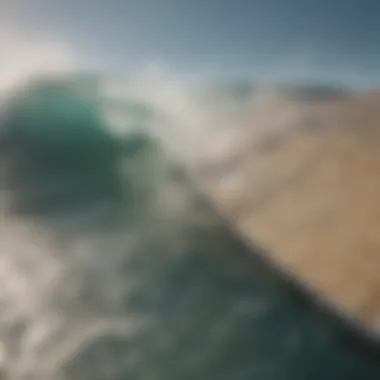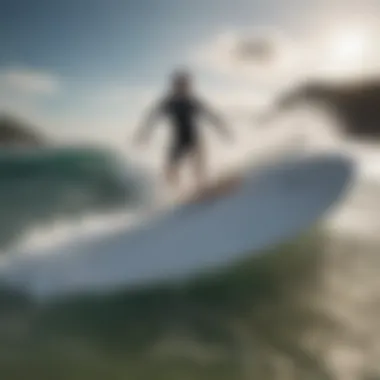Top Intermediate Wakesurf Boards for Enthusiasts


Intro
Wakesurfing isn’t just about the thrill of riding the waves; it’s an evolving dance between the board, the wake, and the surfer. For those who’ve mastered the basics and are looking to elevate their skills, choosing the right board is paramount. The focal point of this article is to furnish intermediate surfers with vital insights, tools, and knowledge about wakesurf boards that will enhance their proficiency and enjoyment on the water.
The journey from novice to intermediate is an exciting one, filled with trials, errors, and learning curves. Intermediate surfers often find themselves at a crossroads: the urge to push boundaries while still refining technique. Navigating this path hinges not only on skill but also on the equipment you choose. Whether it’s a lighter board for agility or a thicker one for more stability, the decision can steer your experience dramatically.
In this exploration, we will peel back the layers on essential features, explore the nuances of shapes, assess materials, and highlight top models that are making waves in the market. Also, we’ll cover accessory essentials, such as fins and traction pads, which help elevate your ride.
Ultimately, this narrative is geared towards giving you, the intermediate surfer, a well-rounded understanding of how to select the perfect wakesurf board tailored to your unique needs and aspirations.
Surf Gear and Equipment
When venturing into the world of wakesurfing, understanding the gear is crucial. The right equipment not only enhances performance but also contributes to safety and comfort on the water.
Latest Surfboard Technologies
The wakesurfing industry constantly evolves, with manufacturers introducing innovative technologies meant to optimize performance. Some key advancements include:
- Lightweight Materials: Modern boards often utilize materials like carbon fiber and epoxy to reduce weight without sacrificing durability, which improves overall maneuverability.
- Hybrid Designs: Boards are increasingly combining features from both surf-style and skim-style boards, allowing for versatility in riding style.
- Rockers and Rail Shapes: A variety of rocker profiles can cater to different riding experiences, providing either smoother rides or aggressive turns based on your preferences.
Choosing a board with the latest technologies can greatly influence how you cut through the water and perform tricks.
Essential Accessories for Surfers
Apart from the board itself, accessories play a substantive role in wakesurfing. Essential items include:
- Traction Pads: These grip the board, providing stability and preventing slipping. Selecting the right pad can aid in controlling the board during jumps or turns.
- Fins: Fins help swimmers steer their boards effectively. The size and type can dramatically alter your board's stability and maneuverability.
- Surf Leashes: A sturdy leash is non-negotiable. It attaches the surfer to the board, ensuring that you don’t lose it in the water, especially useful when mastering new skills.
By investing in quality gear and accessories, intermediate surfers can expect not only an enhancement in performance but a more enjoyable overall experience. Selecting the right equipment will bridge the gap between your current skills and where you aspire to be.
"The right gear can turn a good day on the water into a great one. Invest wisely."
As we move through this guide, remember that the goal is to empower you on your wakesurfing journey, ensuring each ride is better than the last.
Understanding Wakesurfing
Wakesurfing has evolved into a staple water sport, attracting enthusiasts who crave the thrill of riding the wake generated by a boat. Understanding wakesurfing isn’t just about hopping on a board; it involves grasping its essence, techniques, and culture. It’s often said that the water is like a mirror reflecting your skills back at you. Knowing how to read that mirror opens doors to progression and enjoyment.
The importance of grasping the basics starts with board selection. For intermediate surfers, finding the right wakesurf board can significantly impact performance. A well-suited board enables smoother transitions and more control, transforming the journey from beginner flailing to a seasoned surfer dancing on water.
Moreover, recognizing the sport’s nuances enhances your overall experience. You’ll appreciate the camaraderie built amongst fellow surfers, share tips, and become part of a vibrant community. Wakesurfing isn’t merely a pastime; it's a lifestyle that encapsulates a connection with nature and personal expression.
The Basics of Wakesurfing
At its core, wakesurfing involves riding a surfboard while being towed by a boat without being directly connected to it. The sport typically requires a boat specially designed for wakesurfing, creating a sizable, surfable wake. Initiating the ride may seem daunting, but once you master the essentials, riding the wake feels as natural as breathing. Here are some fundamental elements:
- Equipment: Understand the gear involved, including wakesurf boards, life jackets, and the boat you use.
- Starting Procedure: Knowing how to start is crucial. You start behind the boat, holding onto the rope, and gradually let go when you find the sweet spot in the wake.
- Balance and Stance: Maintaining balance is key. A proper stance not only boosts control but increases the fun factor.
Mastering these basics allows you to enjoy the sport to its fullest, enhancing both confidence and skill.
Evolution of Wakesurf Boards
The journey of wakesurf boards from crude designs to today’s sophisticated creations is fascinating. Originally, surfers used makeshift boards that were more akin to skimboards than modern wakesurfers. Over time, as demand grew, several innovations kicked off the revolution in board technology.
- Materials: Early boards were often made of wood, but now, lighter and more durable materials like fiberglass and epoxy are commonplace, enhancing performance and maneuverability.
- Board Shapes: The evolution of shapes has been pivotal. From wider tails that provide stability to narrower profiles allowing sharper turns, variety caters to different surfing styles.
- Tail Styles: Different tail shapes offer unique riding experiences, impacting how quickly a board can pivot or accelerate.
As technology improves, so do the designs. It’s not just about performance; aesthetics now play a role too, with stunning graphics appealing to the eye of many buyers. Embracing these advancements can help intermediate surfers thrive and enjoy the ride. Whether testing out a newer board or perfecting an old favorite, understanding the evolution of wakesurf boards enhances your connection to the sport.
"The sport evolves as its participants do, making every new board a link in the chain of wakesurfing's rich history."
Defining Intermediate Skill Level
Defining the intermediate skill level in wakesurfing is crucial for several reasons. A clear understanding of what constitutes intermediate competence helps riders select the right equipment and approach their progression effectively. It also assists retailers and instructors in guiding customers through their choices, ensuring they find the most suitable wakesurf board for their growing abilities.


Characteristics of Intermediate Surfers
Intermediate surfers often exhibit a combination of skills that differentiate them from beginners. They have generally developed a basic comfort level with the equipment and are not afraid to push their limits. Here are some characteristics that define them:
- Balance and Stability: Intermediate surfers typically show better balance on the board. They can maintain stability in different conditions and can control their body movements with greater precision.
- Basic Tricks: This group can usually perform some basic tricks such as ollies or surface spins. While these moves may still lack the finesse of advanced riders, they demonstrate a progression in skill.
- Speed Control: Intermediate surfers can adjust their speed effectively, allowing them to ride the wave with ease. They are not just passively getting pulled along; they can choose when to speed up or slow down based on wave conditions.
- Wave Riding Techniques: They know how to read the wave patterns and position themselves correctly. This awareness allows them to take advantage of the best spots on the wave for performing tricks or simply enjoying a smoother ride.
"Mastering the ocean's rhythm requires dedication and time. Intermediate surfers are the ones who have taken the essential steps to blend confidence with skill."
Transitioning from Beginner to Intermediate
The transition from beginner to intermediate level is often pivotal in a wakesurfer's journey. For a novice, every element of wakesurfing can feel overwhelming—finding balance, learning to turn, or understanding wave dynamics. As one begins to master these basics, the shift can unlock new experiences and enjoyment in the sport.
To effectively navigate this transition, consider these important elements:
- Regular Practice: Like any sport, frequency is key. Regular outings can help a beginner consolidate what they've learned and are essential for developing muscle memory.
- Focused Learning: It's better to focus on a few skills at a time rather than trying to tackle everything all at once. Choosing one or two tricks to master can boost confidence and provide a sense of accomplishment.
- Feedback and Instruction: Seeking feedback from experienced surfers or instructors can provide valuable insights into areas for improvement. An outside eye can often spot habits that a rider may not be aware of.
- Proper Equipment: Using the right board for this level is crucial. Just because a surfer can ride a board doesn’t mean it suits their current skill set. Choosing boards that are slightly forgiving can aid in the transition.
By understanding where one stands in the spectrum of skill levels, surfers can make informed decisions that enhance their experience on the water. Knowing the markers of being an intermediate allows riders to feel more confident in their abilities and aspirations.
Key Features of Wakesurf Boards
When it comes to optimizing your wakesurfing experience, the key features of wakesurf boards are nothing short of crucial. These elements not only define the board’s performance, but are also instrumental in how they cater to intermediate surfers looking to refine their skills. Each feature contributes to maneuverability, stability, and overall enjoyment in the water, allowing intermediate riders to hone their techniques without the limitations often faced by beginners. Let’s dive into the specific aspects that can make or break your rides on the wake.
Board Shape and Design
The shape and design of a wakesurf board are significant determinants of its performance. The right design can propel you towards better stability and control, critical for balancing on the wave as you navigate the water.
Length and Width Considerations
Length and width are more than just numbers; they play a vital role in how a wakesurf board performs. Longer boards are often favored for their increased stability, making them an ideal choice for intermediate surfers still finding their balance. This extra length helps give a confident rider time to adjust when transitioning between tricks and is generally forgiving when it comes to stability on the water.
Conversely, wider boards offer added surface area, contributing to better buoyancy, which can boost the speed and ease of turns. A key characteristic of wider boards is the ability to maintain speed while providing a solid platform for tricks. However, the trade-off can be more effort in navigating tighter turns because of the increased drag. Knowing your preferred riding style—be it gentler cruising or steering into more aggressive riding—will help you find that sweet spot between the two.
Rockers and Their Impact on Performance
Rocker refers to the curve in the board’s design from nose to tail. The most common types include continuous and three-stage rockers. A continuous rocker provides a smooth ride, helping glide effortlessly across the surface, which is certainly beneficial for both beginners and intermediates. This smoothness aids in control and reduces the chances of catching an edge, which can be detrimental during those early attempts at making sharp turns.
On the other hand, a three-stage rocker offers a more pronounced lift, allowing for increased air during jumps. This can thrill intermediate surfers who are seeking to amp up their performance and incorporate aerial tricks. However, it can also require additional skills to learn transitions effectively, making it less forgiving for those just starting. So, as you assess board rockers, consider how much freedom of movement you want versus the stability you need.
Material Types
The choice of materials used in wakesurf boards impacts everything from ride dynamics to durability. Understanding these differences can help anyone looking to upgrade or choose their first board.
Foam vs. Fiberglass
When you compare foam and fiberglass, you find that each material speaks to different riders’ needs. Foam boards are often lighter and provide excellent buoyancy, making them popular among novices and those who favor a soft ride. Their lightweight nature helps in maneuvering and allowing for those quick turns and easy tricks. However, they can be less durable than fiberglass options.
Fiberglass boards tend to be more durable and offer a more rigid structure, ideal for pushing advanced boundaries. They tend to perform better in rougher water and usually have better longevity in terms of wear and tear. The downside is that they can be a bit heavier, which might turn some surfers off when considering ease of handling.
Epoxy and Its Benefits
Epoxy boards are relatively newer on the scene, and they pack quite the punch in refining surfing performance. What sets epoxy apart is its lightweight, yet incredibly durable nature. This material is resistant to dings and scratches, which can be a constant concern with regular boards.
With an epoxy board, you can expect quicker responses to your maneuvers, allowing intermediate surfers to explore new techniques without worrying about their gear. The lightweight design contributes to greater speed and agility on the water.A possible downside might be the higher price point compared to traditional materials, but for many, the advantages outweigh the costs.
"The right board can transform an ordinary riding session into an extraordinary experience. Understanding how features impact performance truly sets an intermediate surfer on the path to mastery."
Consider the interplay of these features when selecting a wakesurf board; they can make all the difference in your journey across the water. By prioritizing aspects that resonate with your riding style, you’ll enhance not only your skills but also your overall enjoyment as you carve through the wake.
Performance Metrics
Understanding performance metrics is critical when selecting a wakesurf board, especially for the intermediate surfer. Think of performance metrics as the yardstick by which the suitability of a board is measured. These factors significantly influence how a rider experiences both stability and maneuverability on the water. Getting the right balance can make the difference between an exhilarating ride and an uncomfortable one.
Stability and Control


Stability might just be the unsung hero in wakesurfing. It gives surfers the confidence to experiment with various tricks and maneuvers. Without it, every wave could feel like a gamble. An intermediate wakesurfer benefits from boards designed with a lower center of gravity and a wider profile, which helps maintain steadiness as one navigates the wake. A board that wobbles underfoot can lead to frustrating falls, dimming the joy of the session.
For instance, many surfers find that boards with more surface area provide better stability. This characteristic is even more crucial in choppy water; a board that shifts with every ripple can disrupt flow and cause unnecessary strain. Additionally, features like rails and fins influence how well a board holds its line. Boards with well-designed channels help to keep the water flowing efficiently underneath, enhancing both stability and controllability.
"A stable board allows the surfer to focus on their form and tricks rather than battling their equipment."
Control is closely intertwined with stability. A well-balanced board allows for easy weight shifts and transitions. This is especially important for intermediate surfers who are trying to step up their game. The ability to turn sharply without losing balance is an invaluable skill on the water. Features such as thrusters or quad fin setups can enhance responsiveness, providing surfers with the ability to maneuver swiftly and safely.
Speed and Maneuverability
Speed is the heartbeat of wakesurfing. A faster board ensures you’re consistently matching the energy of the wave. However, speed should be balanced with control; what's the point of going fast if you can’t stay upright? The design of a board plays a significant role in this. A pointed nose and streamlined outline can effectively reduce drag, allowing the rider to glide effortlessly across the surface.
Maneuverability refers to a board's ability to pivot and change direction with ease. As intermediates approach more challenging tricks, such as spins and flips, the need for a responsive board becomes paramount. A board with a sharper tail will allow for tighter turns and provide the means to engage with the wake more dynamically. Boards with varied rocker profiles, like a continuous rocker, tend to react differently at high speeds, giving riders versatility based on their surfing style.
Giving attention to both speed and maneuverability can lead to smoother rides, enabling you to explore the full spectrum of wakesurfing capabilities. Whether you are cutting through waves or carving sharp turns, the right board can augment your performance and elevate your experience on the water. The combination of these metrics forms the foundation for selecting an intermediate wakesurf board that enhances your capability and fosters confidence for the next thrilling ride.
Top Wakesurf Boards for Intermediate Surfers
Choosing the right wakesurf board can make all the difference in refining your skills and enhancing enjoyment on the water. For those who have crossed the threshold from beginner to intermediate, this selection process becomes increasingly important. Intermediate surfers often look for boards that offer a perfect balance between stability and agility, allowing them to experiment with tricks while still maintaining control. The diverse options on the market cater to varied preferences and styles, which is paramount for any surfer's progression.
Overview of Leading Brands
When it comes to wakesurfing, several brands are synonymous with quality and performance. Each brand often brings something unique to the table, whether it's innovative design or robust durability. Notable mentions include:
- Hyperlite – Known for their lightweight boards and versatile designs, Hyperlite has been a staple in the wakesurf industry. They cater to all skill levels, but their models for intermediates often stand out due to their ease of use and stability.
- Liquid Force – This brand blends performance with style. Their intermediate boards often feature enhanced edge control, which helps surfers gain confidence in maneuvering.
- Ronix – Offering an array of boards with advanced technology, Ronix emphasizes the balance of performance and comfort. Their focus on reducing drag while maintaining speed is noteworthy.
- O’Brien – Recognized for their affordability without sacrificing quality, O’Brien is a go-to for many looking to get more bang for their buck.
Researching these brands will serve you best in finding the right fits based on personal preferences and riding style.
Comparison of Top Models
Model Specifications
Diving into model specifications is fundamental for understanding how a wakesurf board can complement your surfing. Key elements to scrutinize include length, width, and tail shape. A common choice among intermediate surfers is a board ranging between 5’0” to 5’6” in length. This dimension strikes a balance between buoyancy and maneuverability—ideal for executing tricks.
One favorable feature in many models is the concave base design, which aids in increased speed and smoother rides. Boards with a fuller outline, like that of the Hyperlite Landlock, also assist in providing ample surface area, promoting stability on the wave. This characteristic specifically allows riders to experiment with a range of styles without feeling cramped or restricted.
User Reviews and Feedback
User reviews and feedback can be invaluable when narrowing down options due to the firsthand experiences shared by fellow surfers. Notably, many intermediate surfers appreciate boards like the Liquid Force Swell for its blend of easy handling and responsiveness. Experienced users often laud it for having a forgiving nature during surf sessions, making it easier to build confidence on the board.
On the downside, some reviews might spotlight issues like the board's durability over time. While the Ronix Koal has stellar performance ratings, certain users report that the base can wear out quicker than anticipated with aggressive use.
User experiences serve to illuminate the pros and cons of specific models, helping you weigh the benefits of performance against real-world wear and tear. Gathering this feedback helps shape a more informed purchasing decision.
Cost Considerations
When it comes to selecting an appropriate wakesurf board, the cost is not merely a number; it reflects quality, performance, and durability. If you are navigating the waters as an intermediate surfer, understanding cost considerations is critical. Boards on the market vary widely in price, and having a grip on what you are paying for impacts not only your wallet but also your performance on the water.
Among the crucial elements to navigate are the material costs, brand reputation, and the features that come with higher price points. This section will shed light on why it's important to consider these aspects rather than merely opting for the cheapest available option. A penny-wise-and-pound-foolish approach can lead to dissatisfaction in the long run. In fact, good boards often yield an enhanced surfing experience, underscoring that investing in quality can indeed pay dividends.
"Buying quality gear might feel like an expense, but it’s an investment in your enjoyment and skill."
Understanding Price Ranges
Price ranges for wakesurf boards can be quite the eye-opener. Generally, the prices can fall within the spectrum of $300 to $1,500, depending on various features and specifications. Those on the lower end of the spectrum might find adequate models for beginners, but as you move towards that mid-range ($500 - $900), the offerings tend to get serious.
Here’s a quick breakdown of what you might expect across different price ranges:
- Budget boards ($300 - $500): These often lack the finesse of high-end models. They may have basic shapes and materials but can serve well for practice, especially for beginners.
- Mid-range boards ($500 - $900): This category frequently offers better construction, advanced shapes, and materials like fiberglass or epoxy. You’ll likely find a range of features supporting stability and maneuverability here.
- High-end boards ($900 and above): Expected to be lightweight and constructed with high-grade epoxy, these boards offer the latest technology in wakesurfing. The performance metrics will align more closely with professional riders, ensuring an exhilarating ride.
Understanding these ranges helps you budget appropriately while weighing your choices against the added benefits at various price points.
Value for Money: Is It Worth It?


The question of whether you get good value for money when purchasing a wakesurf board is often ambiguous. On the surface, a more expensive board usually boasts better features, but is that premium really justified?
Here are some considerations to keep in mind:
- Durability and Longevity: Often, a pricier board offers more durability, which translates into significant savings over time. If you end up replacing a cheaper board annually, you’ll likely yield more costs than if you had invested in a solid mid-range option at the outset.
- Performance Enhancements: Boards that come with enhanced features lend themselves to improved performance. This could mean easier tricks, improved balance, or a more enjoyable experience overall.
- Resale Value: Some boards hold their value better than others, especially those from reputable brands. If you ever decide to upgrade, a well-maintained board can fetch a good return.
Ultimately, discerning surfers recognize the relationship between cost and quality. Deciding whether a board is worth its price tag ultimately hinges on how well it complements your evolving skill set and your aspirations in the sport.
By weighing these aspects carefully, you can make an informed decision that won't break the bank while still elevating your wakesurfing experience.
Maintenance of Wakesurf Boards
Maintaining your wakesurf board is like giving respect back to the tool that gives you joy on the water. If you're diving into wakesurfing, you’ve probably realized that having the right board helps you ride the waves better. But another side of the coin is knowing how to take care of that board.
Keeping your board in top shape can not only extend its lifespan but also enhance your overall surfing experience. Whether you have a fancy new model or a trusty older board, the way you treat it matters. After all, you wouldn't let your skateboard gather dust in a shed, right?
Benefits of Maintenance
- Improved Performance: A clean and well-maintained board glides better and can make the ride smoother. Clinging dirt or debris can cause drag.
- Value Retention: Just like a classic guitar, a well-cared-for wakesurf board keeps its value over time.
- Safety Assurance: Ensure that your board is free from cracks and damages to maintain safety during use.
Some might think maintenance is a chore, but it’s more about establishing a routine that enhances your surfing experience. Let’s dive into the specifics.
Cleaning and Storage Tips
Cleaning
Regular cleaning doesn't have to feel like pulling teeth. After each session, make it a habit to rinse off your board with fresh water to get rid of salt and sand. This simple step can keep the board looking fresh for years to come. Here's how you can do it:
- Use a soft sponge or cloth to avoid scratching the surface.
- If you notice stubborn stains, a mild soap solution can do wonders.
- Dry it off completely with a towel to reduce moisture that can lead to mold or mildew.
Storage
Storing your board correctly is crucial for its preservation. Here are some pointers for smart storage:
- Keep it in a cool, dry place. Extreme temperatures can warp your board.
- Avoid stacking multiple boards, which can lead to pressure points that damage them.
- Use a board bag. Not only does it provide protection, but it’s also easier to carry.
Remember: The way you store your board can either make or break its longevity.
Repairing Common Issues
Wakesurf boards are built tough, but even the best can suffer bumps and scrapes along the way. Knowing how to fix a few common issues can save you a trip to the shop.
Common Repairs
- Dings and Dents: For small dings, some marine epoxy or board repair kits work wonders. Follow the instructions for proper application.
- Fins: If your fins are loose or missing, replace them promptly. A loose fin can lead to instability on the water.
- Rusted Hinges: If your board has a removable fin system, keep those hinges clean and free of rust for a better grip and easier adjustments.
- Delamination: If you see any separation between layers, act fast. Use a clamp to hold the areas in place and apply adhesive to seal them up.
Keeping these maintenance tips in mind will not only prolong the life of your wakesurf board but can also enhance your performance and enjoyment on the water. More than anything else, treating your wakesurf board with love and care will allow you to focus on what really matters—catching those perfect waves.
End and Recommendations
In the pursuit of finding the right wakesurf board, embracing the journey through the realm of intermediate wakesurfing is essential. This section not only caps off the previous discussions but also serves as a thoughtful reminder of the key aspects to consider when choosing a board. A good wakesurf board isn’t merely a piece of equipment; it’s an extension of the surfer’s abilities, preferences, and aspirations. With so many options on the market, making an informed decision can elevate your surfing experience significantly.
When selecting a board, it’s crucial to prioritize stability, control, and performance metrics. Each of these elements can have a profound impact on your ability to hone skills and enjoy the ride. Performance can be a game changer, and understanding how different boards react to conditions can make all the difference.
Final Thoughts on Choosing the Right Board
Choosing the right wakesurf board is akin to finding the perfect dance partner. You want something that complements your movements and enhances your style on the water. One must consider the rider's weight, skill level, and personal preferences, as well as the unique characteristics of each board. Board shape, size, and material all play crucial roles. An intermediate surfer looking to progress should opt for a board that's responsive but forgiving. Do not shy away from testing a few to get a sense of what truly feels right.
A deeper understanding of how your board interacts with the water can also lead to a more satisfying ride. Pay attention to the local wave conditions too; different environments may benefit from different board attributes. Ultimately, find a board that feels like a match you never knew you needed.
Next Steps in Your Wakesurfing Journey
Having wrapped up the board selection process, it’s time to think about your next steps. Think of this as a roadmap to greater achievement in your wakesurfing adventures. Start by practicing consistently; the more hours you put in, the finer your skills will become. Experiment with different techniques and tricks; it might be a bit daunting at first, but pushing your limits will yield impressive results.
Engaging with the wakesurfing community is also invaluable. Conversations with fellow surfers, whether on social media platforms like Reddit or local meet-ups, can provide insights that are often lost in articles and guides. You might discover new techniques, gain access to events, or even uncover board recommendations that you hadn’t considered.
Lastly, always revisit the fundamentals. Even as you progress, maintaining a solid grounding in the basics ensures that more advanced maneuvers feel second nature as you master them.
In summation, your journey does not end with selecting a board; it merely marks the beginning of a deeper relationship with the sport. Your commitment to continual growth and community engagement will define your experience long after you've made that initial board purchase.















